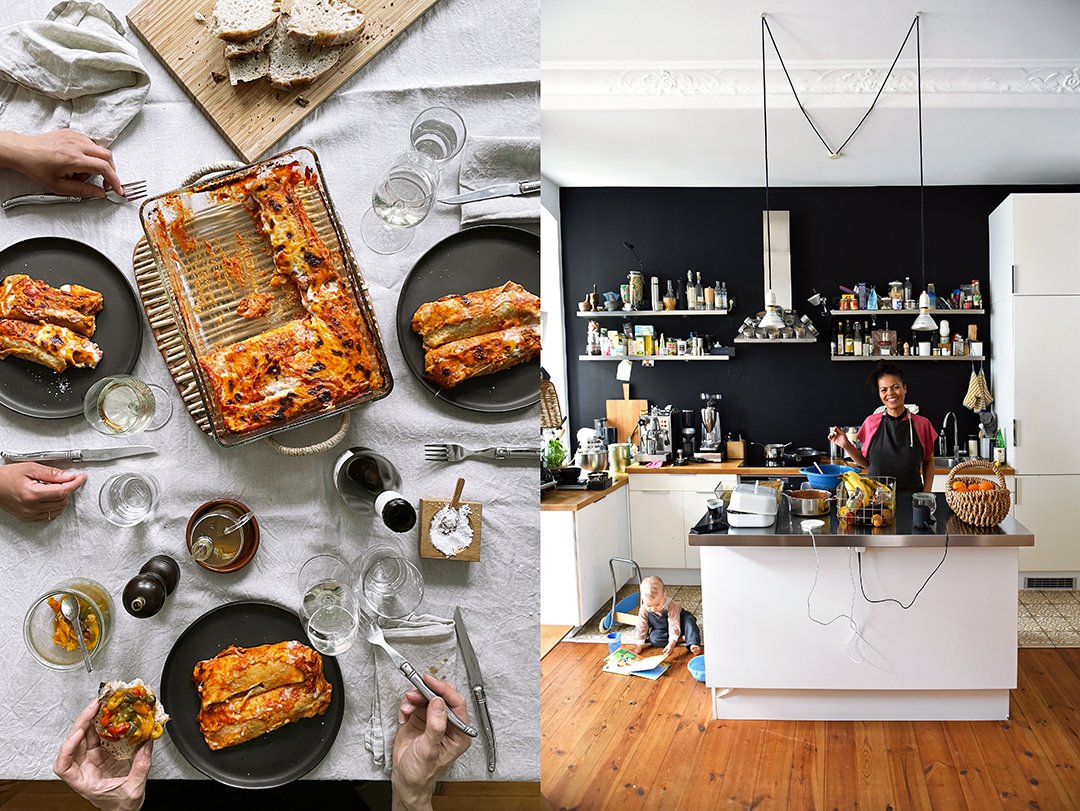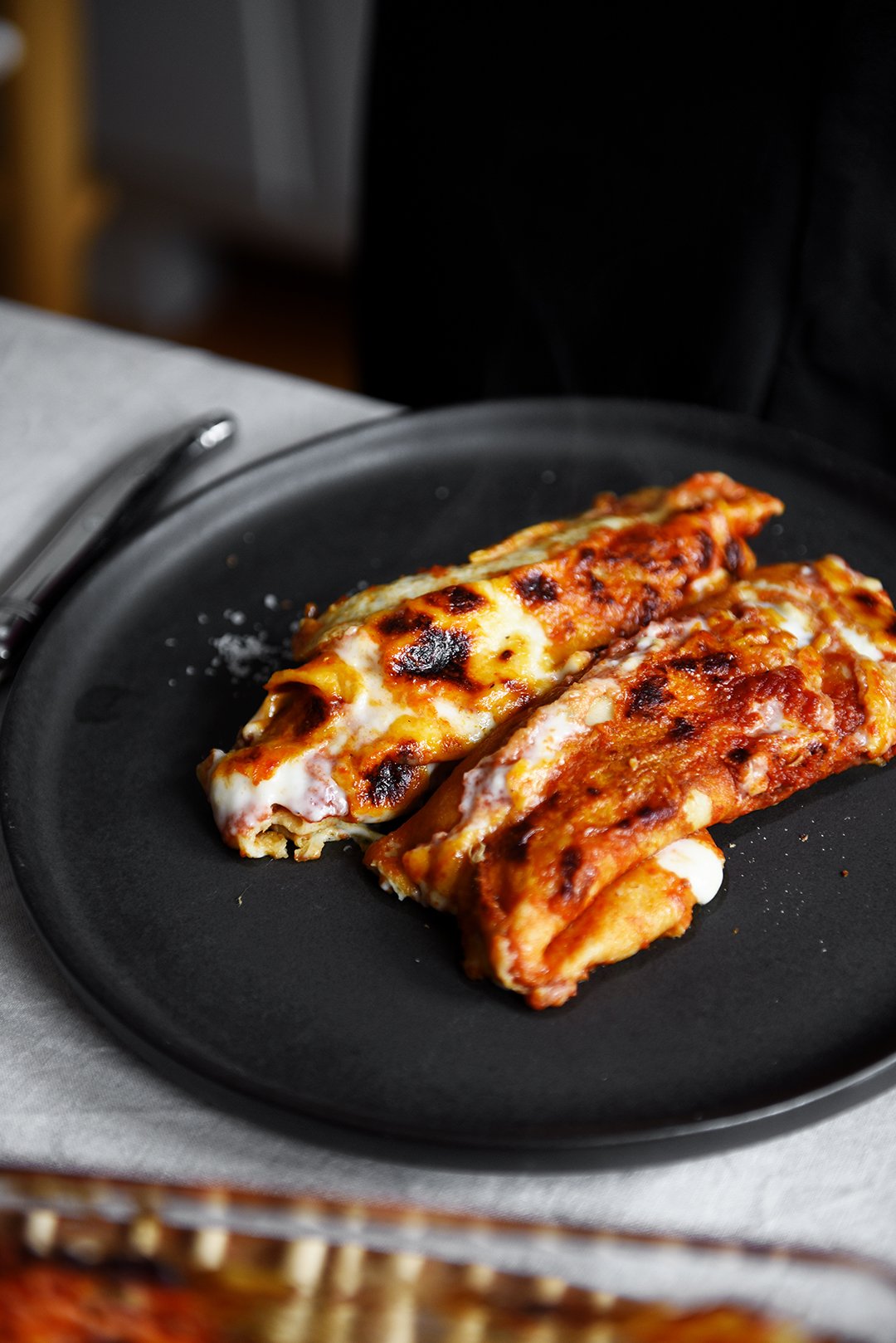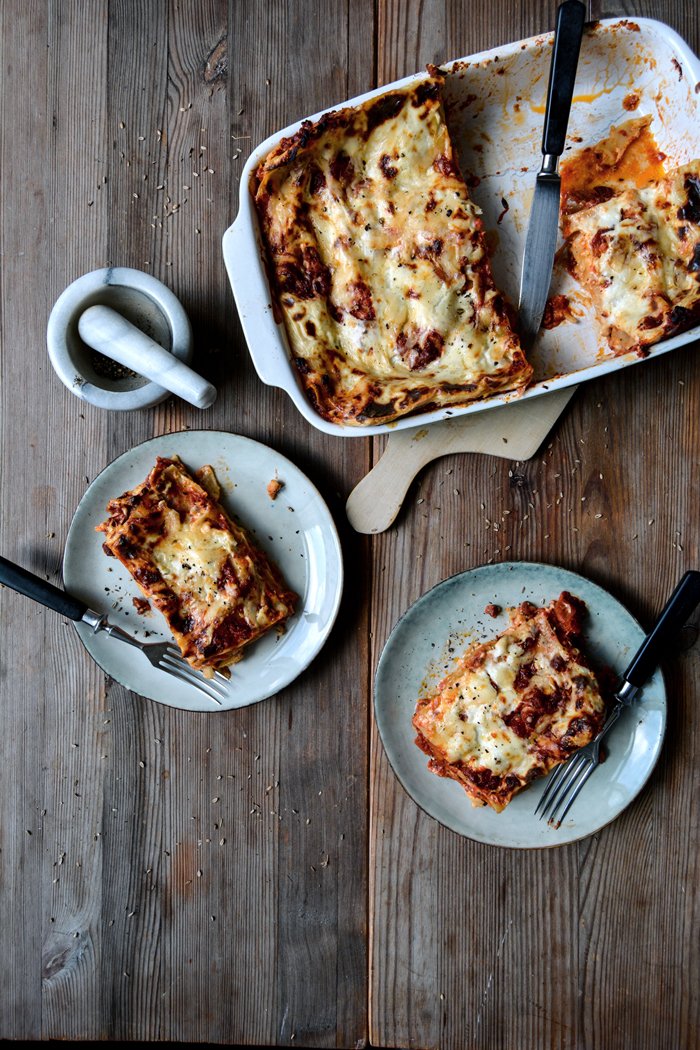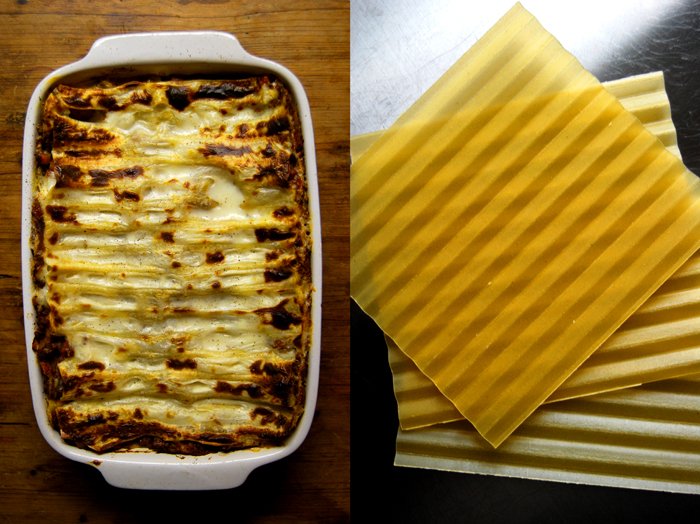Meet In Your Kitchen | Maria's Cannelloni al Ragù
This post is part of my Meet in My Kitchen podcast: How did we get to where we are in life & what does food have to do with it
“I think it’s amazing that we need to eat to survive but the way to survive is to do something that is amazing to do, that you can enjoy, that you have the privilege, the luxury, three, four times a day to do something out of necessity that you can enjoy as one of the I would say best things there is in life.” - Maria Gerace
The first time I met Maria Gerace she came to a Saturday lunch at my apartment, we started at noon and parted at 4 in the morning. Mussels, crêpes, late night pasta, and many bottles of vino - that was the perfect start of a friendship that would always circle around food, wine, and long conversations. When I go to Maria's kitchen she makes cannelloni for me - not a couple but 20 (you can find the recipe below, Maria uses crespelle/ crêpes for the cannelloni instead of cannelloni pasta). In her kitchen, she's my Italian mamma who always takes care that my plate (and glass) is never empty!
Maria grew up in a small town in Calabria, close to the sea, right at the tip of Italy's boot and far away from the life she was longing for. She was raised by her grandmother who planted the seed in the young girl's soul that a good life is always connected to good food and to people to share it with.
At a young age Maria was already used to patiently peeling pounds of fava beans in the evening in front of the TV; to making passata in the garage once a year with the entire family, each member having at strict role in the procedure - a hierarchy that only slowly alters with age. Food was never just prepared for oneself, but always shared with the whole family. The famous Sunday tomato sauce enriched with polpettine, a weekly ritual, which smell and taste is so deeply woven into her memory, was a frugal feast in her granny's kitchen that no family member dared to miss. The young ones brought their boyfriends and girlfriends, the aunts and uncles sharing laughs and stories, a constant flow of people pulled to the kitchen of a woman who held everything and everybody together like a magnet.
Once a year the family would gather and go on a 'pilgrimage' to slaughter a pig at a small village close by. The blood would be collected immediately to make sanguinaccio, cooked with cocoa, sugar, and spices it was turned into a rich chocolate sauce that the kids loved. Even for the young ones it was normal that every part of an animal was used, that the whole family would always be involved in every food endeavor, and that there were recurring culinary rituals that marked the flow of the year and made it special. Traditions that everyone was longing for.
Although her curiosity and hunger for life made her leave the south of Italy to study industrial design in Milan, to travel and experience the world and widen her view, to then settle in Berlin with her husband Jan and work as an eyewear designer, Maria's voice always mellows when she talks about her granny, about Italian food, and the sea.
The podcast episode with Maria Gerace is in English. You can listen to the Meet in My Kitchen podcast on all common podcast platforms; there are English and German episodes. You can find all the blog posts about these podcast episodes including my guests' recipes here on the blog under Meet in Your Kitchen.
Listen to the podcast episode with Maria on:
Spotify / Apple / Deezer / Google / Amazon / Podimo
On Instagram you can follow the podcast @meetinmykitchenpodcast!
Cannelloni al Ragù
by Maria Gerace
There are many steps involved in the preparation of this dish, so it makes sense to cook it in larger quantities.Cannelloni freeze very well. Follow this recipe and freeze them (in the baking dish) before (!) baking the crespelle in the oven. After defrosting them you can bake them following this recipe again. You can also prepare the ragù and the tomato sauce a day ahead.The crêpes and béchamel sauce (in case you don't use store bought sauce) should be made the day you finish the preparation and then either bake or freeze the cannelloni.
Makes about 20 crespelle / Serves 7-10
For the ragù (you can prepare the ragù a day ahead)
100 ml / 1/3 cup plus 2 tablespoons dry white wine
Extra virgin olive oil
1 medium onion, peeled and finely diced
1 medium carrot, peeled and finely diced
1 stalk of celery, peeled and finely diced
1 clove garlic, peeled and finely chopped
500g / 17 2/3 ounces ground beef (or mixed beef/ pork)
1kg / 2 1/4 pounds canned whole peeled tomatoes, crushed (or canned crushed tomatoes)
Fine sea salt
Freshly ground pepper
Nutmeg, preferably freshly grated
For the crêpes
600ml / 2 1/2 cups whole milk
1 tablespoon extra virgin olive oil
3 large eggs
225g / 1 3/4 cups all-purpose flour
Nutmeg, preferably freshly grated
Fine sea salt
Unsalted butter, to cook the crêpes
For the tomato sauce (you can prepare the tomato sauce a day ahead)
Extra-virgin olive oil to taste
1 clove garlic
500g / 17 1/2 ounces tomato passata
Fine sea salt
To finish the cannelloni
1 liter / 4 1/4 cups thick béchamel sauce*
Parmesan, freshly grated
Nutmeg, preferably freshly grated
500g / 17 2/3 ounces Provola cheese, cut into cubes
* Here is my recipe for béchamel saucefrom my book '365'
1 liter / 4 1/4 cups whole milk
1 large bay leaf
Nutmeg, preferably freshly grated
Fine sea salt
Finely ground pepper
45g / 3 tablespoons unsalted butter
45g / 1/3 cup all-purpose flour
For the ragù, simmer the white wine in a medium saucepan for 5 minutes to boil off the alcohol and reduce acidity. In a large pan, heat a splash of olive oil over medium-high heat, add the onion, carrot, celery, and garlic, and sauté, stirring occasionally, for about 4 minutes. Add the ground beef and a little olive oil and cook over high heat, stirring to break up the meat, for a few minutes or until the meat is browned. Add the wine and deglaze the pan, using a spatula to scrape any bits and pieces off the bottom, then add the tomatoes. Season to taste with salt, pepper, and nutmeg and gently simmer over medium-low heat for 1-2 hours; the ragù should be thick. Place a large colander in a deep sheet pan then pour the ragù into the colander to drain any excess liquid; for the filling, the ragù needs to be very thick and not runny. Set the sauce collected in the sheet pan aside. Let the ragù cool completely.
For the crêpes, whisk together the milk, olive oil, and eggs then add the flour and a pinch of nutmeg and salt and whisk, using a stand mixer or a whisk, until smooth and well combined. Let the batter sit for about 30 minutes.
For the tomato sauce, heat a splash of olive oil in a large pan over medium heat. Add the garlic and sauté for a few minutes then add the passata, season with a pinch of salt,and cook for 10 minutes. Remove the garlic then let the sauce cool for at least 15 minutes.
For the béchamel sauce, combine the milk, bay leaf, 1/4 teaspoon of ground or freshly grated nutmeg, 1/4 teaspoon of salt, and a pinch of pepper in a medium saucepan and bring to a boil. Immediately take the pan off the heat, remove and discard the bay leaf, and set aside. To make the roux for the béchamel, melt the butter in a separate medium saucepan over medium-high heat and as soon as it’s sizzling hot, whisk in the flour. Slowly pour the hot milk mixture into the roux and whisk until smooth. Simmer on low, whisking occasionally, for about 5 minutes or until the sauce starts to thicken. Season to taste with nutmeg, salt, and pepper and set aside.
To cook the crêpes, spread out 4-6 kitchen towels on a work surface. In a 20 cm / 8“-non-stick pan or cast iron skillet heat 1/2 teaspoon of butter over medium-high heat. Pour in a ladle of the batter, tilting and turning the pan so that the batter spreads evenly and very thinly. Cook the crêpe, flipping once, for about 30-60 seconds per side or until golden. Spread the crêpe on the prepared kitchen towels and continue cooking about 19 more crêpes with the remaining batter, adding a little butter to the pan and adjusting the heat as necessary.
Preheat the oven to 180°C / 350°F.
To finish the cannelloni, spread a little tomato sauce on the bottom of 2 large baking dishes, drizzle with a little béchamel sauce, and sprinkle with a little Parmesan. Season each crêpe with a little nutmeg and sprinkle with a little Parmesan. Place a generous spoonful of the ragù in the middle of each crêpe and top with Provola and a spoonful of béchamel sauce. Gently roll each crêpe into a tight wrap and arrange them tightly, side by side, in the prepared baking dishes. Cover the crêpes with the remaining tomato sauce, the sauce collected from the ragù, and the béchamel sauce, sprinkle with a little Parmesan, and bake for 30-40 minutes or until it’s bubbling and the top is golden brown. Let the crespelle sit for a few minutes before serving.
Fennel Tomato Lasagna with Crunchy Bacon
A couple days ago, I went to a meeting that finished much earlier than expected. I stepped out into the street on that cold and grey morning and decided to squeeze in a quick coffee. Just a creamy cappuccino, a flaky chocolate croissant, and a peaceful moment to myself. I went to my favorite Italian deli for a bit of dolce vita - sipping a fantastic coffee while listening to the patron chatting with his customers in Italian, accompanied by a medley of Italian operas. A toddler giggled, two dogs observed the busy scene. The shelves around me presented a tempting selection of chiantis, pasta, polenta, capers, and bottarga. The counter right in front of me filled with various prosciuttos, salami, ciabatta sandwiches, and homemade pasta treats. And right next to it, bowls of every antipasti one can possibly think of. Just the thought of it makes me hungry again.
This is the kind of scene that makes you want to go straight to your kitchen, open a bottle of wine, and start cooking. Italian of course. The weather doesn't leave the slightest doubt that spring isn't near yet, so a hearty lasagna is the best thing to have on your plate. Mine is filled with lots of juicy tomatoes, roasted fennel seeds, and fennel bulb thinly sliced and sautéed, plus crunchy bacon bites, dried chili peppers, a bit of Parmesan, and a creamy béchamel sauce. At first, I wanted to combine the fennel with a meaty bolognese but then I remembered a pasta dish that I shared on the blog almost two years ago and that changed my mind. You could leave out the bacon, but I recommend leaving it in: the fennel seeds roast in the meat's salty juices and merge with the tinned tomatoes - and become a heavenly sauce. Layered with pasta sheets and the crisp fennel bulb, it's just what I want on a cold day in February.
Fennel Tomato Lasagna with Crunchy Bacon
Serves 4 to 6
For the béchamel sauce
milk 700 ml / 3 cups
a pinch of nutmeg, preferably freshly grated
fine sea salt
ground pepper
unsalted butter 30g / 2 tablespoons
plain flour 30g / 4 tablespoons
large bay leaf 1
For the lasagna
butter, for the baking dish
olive oil
cored fennel bulb, thinly sliced lengthwise, 340g / 12 ounces
fine sea salt
black peppercorns, crushed in a mortar
thick-cut bacon, cut into very small cubes, 200g / 7 ounces
fennel seeds 2 tablespoons
garlic, crushed, 3 cloves
small dried chili peppers, 2
peeled whole tinned tomatoes, chopped, 1.2kg / 2 2/3 pounds
no-boil lasagna noodles, about 250g / 9 ounces
freshly grated Parmesan 100g / 3 1/2 ounces
For the béchamel sauce, combine the milk, nutmeg, and pinches of salt and pepper in a medium saucepan and bring to a boil. Immediately take the pan off the heat and set aside.
To make the roux for the béchamel, melt the butter in a clean medium saucepan over medium-high heat and as soon as it’s sizzling hot, whisk in the flour. Slowly pour the hot milk mixture into the roux and whisk until smooth. Add the bay leaf and simmer on low, whisking occasionally, for 2 to 3 minutes or until the texture starts to thicken. Remove and discard the bay leaf. Season to taste with nutmeg, salt, and pepper then cover, and set aside.
Preheat the oven to 180°C / 350°F (conventional setting) and butter a 26 x 20 cm / 10 x 8" baking dish (or a dish of roughly this size).
In a large, heavy pan, heat a generous splash of olive oil over medium-high heat and sauté the fennel slices in batches for about 1 minute per side or until golden and al dente. Spread out the fennel slices next to each other in the pan so that they cook evenly. Season with salt and pepper and transfer to a plate.
Put the pan back on the heat and cook the bacon over medium-high heat for about 7-10 minutes or until golden brown and crunchy. Add a little oil if necessary and stir once in a while. Scrape the bacon to the sides of the pan, add a little olive oil (if the pan is too dry) and the fennel seeds, garlic, and chili. Turn the heat down to medium and cook for 2 minutes, mind that the seeds don't turn too dark. Add the tomatoes, season with salt and pepper, and, stirring occasionally, cook for about 10 minutes over medium-high heat or until thickened. Season with salt and pepper to taste. Take the pan off the heat and set aside 3 tablespoons of the sauce (for the final layer of the lasagna).
Arrange a layer of pasta on the bottom of the buttered baking dish and spread with 1/3 of the tomato-bacon sauce and sprinkle with 1/4 of the béchamel. Top with 1/3 of the sautéed fennel and 1/4 of the Parmesan. Repeat to make 3 more layers, top the last layer with pasta. Sprinkle with the reserved 3 tablespoons of the tomato-bacon sauce and the remaining béchamel and Parmesan. Bake for 35-45 minutes (depending on the lasagna package instructions) or until the pasta is al dente. To brown the cheese a little, you can switch on the broiler for the last 1 to 2 minutes. Let the lasagna sit for 5 to 10 minutes before serving and sprinkle with some crushed peppercorns. Enjoy!
An earthy Chard and Ricotta Lasagna
One of the qualities of chard, besides its wonderful taste, is that it gives me a spring feeling even in the coldest and darkest February evening. The thick green leaves are a promising hint of all the fresh green which will be on my plate in the next months, but for now I gladly enjoy this versatile vegetable. Chard tastes similar to spinach, but stronger with earthy flavours. I like it in combination with pasta and milky cheese. For a quick and easy dinner I chop the leaves roughly, cut the thicker stems into very thin slices, fry them in oil and deglaze everything with a glass of white wine. Mixed with spaghetti, some heavy cream and parmesan it's a wonderful pasta dish.
With a bit more time, chard makes a delicious lasagna together with ricotta, Béchamel and some parmesan. For a cold night, I recommend this comfortable dish. It's done after less than half an hour in the oven, you just need to blanch the chard beforehand and prepare the Béchamel.
Chard and Ricotta Lasagna
I use a 27cm x 20cm / 10.5″ x 8″ baking dish, definitely big enough for 4 people.
For the chard
chard, rinsed, 500g / 18 ounces
nutmeg, ground
salt and black pepper
Bring a large pot with water to the boil. Cut the soft green of the chard into 1 cm / 1/2" strips and the hard white parts into very thin slices. Salt the water, first boil the white slices of chard for a couple minutes until al dente, then throw in the the green as well and cook for 1 minute. Take the chard out of the water and rinse in a sieve with cold water for 1-2 seconds. Season with salt, pepper and nutmeg to taste and set aside.
For the Sauce Béchamel
milk 600ml
butter, 30g / 1 ounce
plain flour 30g / 1 ounce
bay leaf 1
a pinch of nutmeg, grated
salt and black pepper
Mix the milk with the nutmeg, salt and pepper and bring to the boil. In a sauce pan, melt the butter and whisk in the flour. Pour the hot milk into the roux and continue mixing till smooth. Add the bay leaf and simmer for around 5 minutes on low heat until the texture is thick and smooth. Take the bay leaf out and season with salt and pepper.
For the Lasagna
lasagna pasta sheets around 250g / 9 ounces
ricotta 250g / 9 ounces
Parmesan, grated, 4-6 tablespoons
Set the oven to 180°C / 355°F and butter the baking dish.
Put down a layer of pasta in the baking dish, spread with 1/2 the chard, pour 1/3 of the Béchamel over it and sprinkle with 1/2 of the ricotta (in big lumps). Repeat with another layer of pasta, the rest of the chard and ricotta and 1/3 of the Béchamel, cover with the final layer of pasta and the remaining Béchamel. Sprinkle with parmesan. Bake for 25 minutes or until the pasta is done, switch on the grill for 2 minutes or until the pasta becomes golden brown and partially crisp.
Lasagna with Sauce Bolognese and Parsnip
Rich, with a fruity sauce Bolognese with lots of tomatoes and herbs, parsnip, Parmesan and a bit of chicken liver - that's my lasagna and I enjoy every hearty bite of it! I take the casserole dish with the steaming lasagna out of my oven and by the time I put it on the table it has already filled our entire apartment with the sweetest, mouth-watering smell of herbs, baked cheese and tomatoes. It's a real teaser!
It's only my second time using wavy lasagna pasta and I'm impressed with the result. They are done within just 25 minutes (still al dente), the lasagna keeps its shape on the plate and - most importantly - it gets a crispy crust on top, neither too hard nor too dry. I make my sauce Bolognese with pure minced beef and a bit of chicken liver. You don't really taste the liver but it makes the beef taste more intense. I add carrots and parsnip as I prefer a balanced mixture of meat and vegetables in a sauce Bolognese in general. I cook the sauce for about an hour with red wine, tomato paste, thyme and rosemary - it is very concentrated and strong. And finally the cheese! Parmesan is the perfect choice as it's so tasty that you don't need to use much, which would just make the meal cheesy and heavy.
Lasagna with Sauce Bolognese and Parsnip
I use a 27cm x 20cm / 10.5" x 8" baking dish, definitely big enough for 4 people.
For the Sauce Bolognese
minced beef 300g / 10.5 ounces
organic chicken liver, chopped, around 100g / 3.5 ounces
carrot, sliced, 1
parsnip, sliced, 2
onion, chopped, 1
tinned tomatoes, chopped, 400g / 14 ounces
red wine around 500ml (you could also use 250ml red wine and 250ml broth)
tomato paste 2 tablespoons
a sprig of thyme
a sprig of rosemary
garlic, crushed, 1 clove
salt and pepper
olive oil for frying
Heat the oil in a large pan and fry the vegetables for a couple minutes on medium heat. Add the meat (beef and liver) and fry until all the liquid dissolves. Add the tomato paste, mix and fry for a minute. Deglaze with a little red wine, mix, cook for a minute and repeat two more times. Add the tinned tomatoes and the rest of the wine (you might not need all of it at once). Add herbs, garlic, salt and pepper and simmer on low temperature for about an hour. Stir in between and add more wine if the sauce becomes too dry. Season with salt and pepper to taste.
For the Sauce Béchamel
milk 600ml
butter, melted, 30g / 1 ounce
plain flour 30g / 1 ounce
bay leaf 1
a pinch of nutmeg, grated
salt and pepper
Mix the milk with the nutmeg, salt and pepper. Whisk the flour into the hot butter. Bring the milk to the boil and whisk into the roux. Continue mixing until smooth. Add the bay leaf and cook for around 5 minutes on low heat until the texture is thick and smooth. Take the bay leaf out and season with salt and pepper.
For the Lasagna
lasagna pasta around 250g / 9 ounces
Parmesan, grated, around 100g / 3.5 ounces
Set the oven to 180°C / 355°F.
Butter your baking dish. Put down a layer of pasta, 1/3 of the sauce Bolognese, 1/4 sauce Béchamel and some Parmesan. Repeat twice, cover with a final layer of pasta (you should have 4 layers of pasta) and cover with sauce Béchamel and Parmesan. Bake for 25 minutes or until the pasta is done, switch on the grill for 2 minutes or until the pasta becomes golden brown and partially crisp. Take the lasagna out and let it sit for 10 minutes.






























